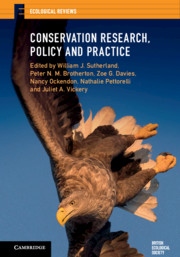Contents
Part I:Identifying priorities and collating the evidence
5.Understanding local resource users’ behaviour, perspectives and priorities to underpin conservation practice
6.Mobilisation of indigenous and local knowledge as a source of useable evidence for conservation partnerships
7.Informing conservation decisions through evidence synthesis and communication
8.Aligning evidence for use in decisions: mechanisms to link collated evidence to the needs of policy-makers and practitioners
Part II:Influencing and making decisions
10.Effective engagement of conservation scientists with decision-makers
12.The natural capital approach to integrating science, economics and policy into decisions affecting the natural environment
13.Working with government – innovative approaches to evidence-based policy-making
14.Approaches to conflict management and brokering between groups

